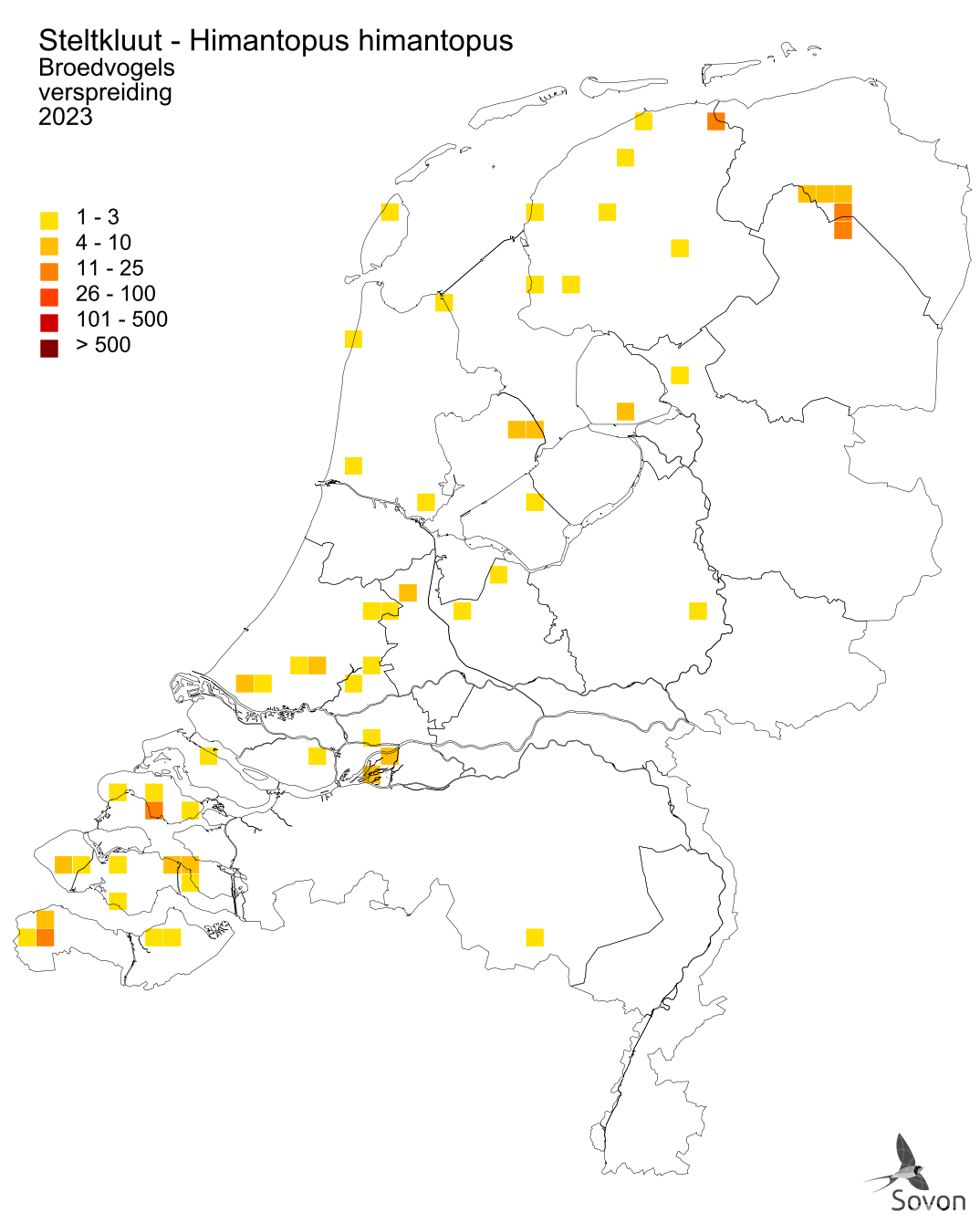Verspreiding en trends
Verspreiding

Deze kaart is gebaseerd op landelijke tellingen van kolonievogels en zeldzame broedvogels (Meetnet Broedvogels). Per atlasblok van 5x5 km is het aantal broedparen gegeven.

Deze kaart is gebaseerd op losse waarnemingen uit het Bijzondere Soorten Project (BSP). Ze zijn weergegeven op de schaal van 5x5 km blokken.
Aantalsontwikkeling
broedvogeltrend
Deze grafiek is gebaseerd op het Meetnet Broedvogels (kolonies en zeldzame broedvogels). Weergegeven is het jaarlijks aantal broedvogels/territoria.
- vanaf 1980
- significante toename, >5% per jaar (++, minimaal verdubbeling in 15 jaar)
- laatste 12 jaar
- significante toename, >5% per jaar (++, minimaal verdubbeling in 15 jaar)
Broedsucces en overleving
Onvoldoende gegevens beschikbaar voor trendanalyse.
Seizoensvoorkomen
seizoenspatroon
Deze gegevens zijn gebaseerd op losse waarnemingen uit het Bijzondere Soorten Project (BSP)
Beschrijving voorkomen
Buiten broedtijd
Niet-broedende Steltkluten worden voornamelijk tussen april en september gezien op ondiepe zoete tot brakke wateren. De jaarlijks waargenomen aantallen schommelen hevig. Net als bij broedvogels is er een verband met de neerslaghoeveelheden in Zuid-Europa in het voorjaar. In droge voorjaren in Spanje en Zuid-Frankrijk komen er meer Steltkluten naar Nederland toe.
Broedtijd
Steltkluten broeden vanaf 1931 in Nederland. Jaren waarin de soort zeldzaam is worden afgewisseld met jaren waarin tot meer dan honderd paren een broedpoging wagen. Ondiepe moerasgebieden in het laaggeleden deel van Nederland zijn favoriet. Soms nestelen verschillende paren dicht bijeen. Topjaren in Nederland vallen samen met bijzonder droge voorjaren in Zuid-Europa. Blijkbaar dwingt dit Steltkluten om het noordelijker binnen Europa te zoeken. Broedgevallen in Nederland leverden voor de eeuwwisseling weinig vliegvlugge jongen op, maar tegenwoordig worden er geregeld succesvolle broedgevallen gemeld.
Vogelrichtlijn
Staat van instandhouding
De Vogelrichtlijn richt zich op de instandhouding van alle natuurlijk in Europa in het wild levende vogelsoorten waaronder de Steltkluut.
Dit betekent dat de EU-lidstaten maatregelen moeten nemen om de populaties van deze soorten op een niveau te houden of te brengen dat met name beantwoordt aan de ecologische, wetenschappelijke en culturele eisen. Daaronder wordt onder andere een gunstige staat van instandhouding verstaan. Het begrip Staat van instandhouding is zo ongeveer synoniem voor de mate van duurzaamheid of gezondheid van een populatie van een soort.
De Vogelrichtlijn verlangt van de lidstaten dat ze leefgebieden voor vogels in voldoende omvang en kwaliteit in stand houden, waaronder door de aanwijzing van speciale beschermingszones ten behoeve van het Europese Natura 2000-netwerk. Voor de Steltkluut zijn in Nederland geen speciale beschermingszones aangewezen. De landelijke populatie moet zich wel op een gunstig niveau kunnen handhaven.
Methodiek voor de bepaling van de Staat van instandhouding van vogels
broedvogel
De Staat van Instandhouding van de Steltkluut als broedvogel in Nederland is gunstig.
| Beoordeling Staat van Instandhouding | ||||
| Verspreiding | Populatie | Leefgebied | Toekomst | Eindoordeel |
| gunstig | gunstig | gunstig | gunstig | gunstig |
Aangewezen gebieden
Er zijn geen gebieden aangewezen voor deze soort.
Telrichtlijnen
Broedvogels
Methode
Territoriumkartering
Tijd van het jaar
Begin mei t/m eind juli
Tijd van de dag
Gehele dag, wellicht enige voorkeur voor avond.
Datumgrenzen, normbezoeken en fusieafstand
| geldige waarnemingen | normbezoeken | minimaal vereist | fusie- | |||||||||
| adult | paar | terr | nest | migrant | 1 | 2 | 3 | seizoen | datumg | datumgrens | afstand | |
| . | X | X | X | 2 | 10-5 t/m 15-7 | 1000 | ||||||
Aanwijzingen
Alle waarnemingen in geschikte biotoop (zeer variabel, zie Broedbiologie) noteren en letten op territorium- of nestindicerend gedrag: aanwezig paar (let op verschillen in verenkleed) [broedcode 3], balts (met sprongetjes in de lucht) [brc 2,5], nestbouw [brc 9], alarm (met veel roepen nerveus rondvliegen boven broedplaats; schijnaanvallen; met hangende poten boven verstoringsbron blijven) [brc 7], pulli (vaak in dichte vegetatie verblijvend) [brc 12]. Locaties waar paring, broeden en opgroeien van de jongen plaatsvinden kunnen vele kilometers uit elkaar liggen. Mislukte broedvogels vertrekken vaak onmiddellijk uit het terrein.
LET OP: alarmeren soms op plekken ver van locatie waar nesten zijn en onduidelijk of deze vogels überhaupt een nest hebben.
Documentatie
Documentatie nodig. Mislukte broedgevallen uiteraard doorgeven.
Broedbiologie
Zowel in zoete als brakke milieus voorkomend in open landschappen met ondiep water en zowel slik- of zandstroken en (enige) vegetatie. Broedgevallen in allerlei biotopen mogelijk, van voormalige schorren en kreken tot droogvallende vennen, vernatte hoogvenen, vloeivelden, geïnundeerde polders en opspuitterreinen. Bodemnest op eilandjes, in oevervegetatie, op drijvende vegetaties et cetera. Solitair of in kleine 'kolonies' nestelend.
Vogels vanaf derde kalenderjaar geslachtsrijp. Eileg half mei tot half juni (vrij variabel). Eén broedsel per jaar, meestal 3-4 eieren, broedduur 22-24 dagen, jongen (nestvlieders) na 28-32 dagen vliegvlug. Familieverband (beide partners verzorgen jongen) soms nog tijdens trek intact.
